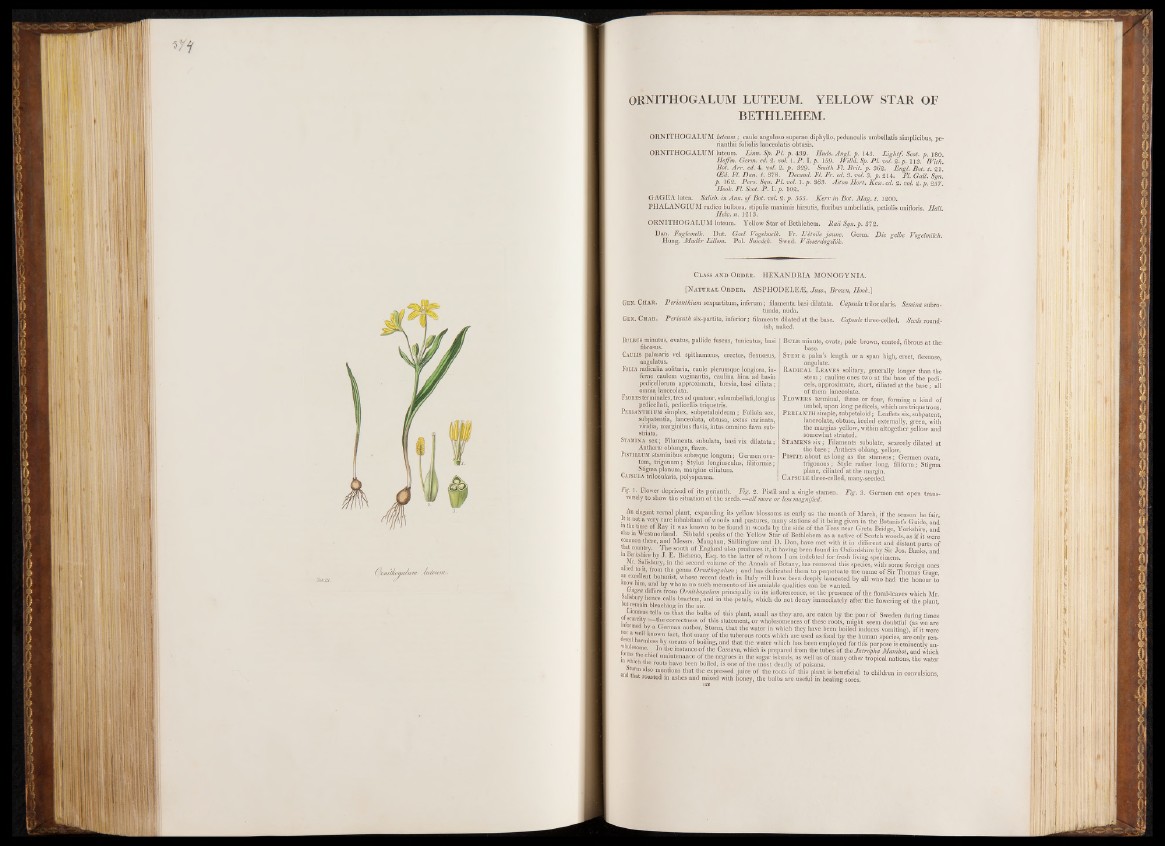
ORNITHOGALUM LUTEUM. YELLOW STAR OF
BETHLEHEM.
ORNITHOGALUM luteum; caule anguloso superne diphyllo, pedunculis umbellatis simplicibus, pe-
rianthii foliolis lanceolatis obtusis.
ORNITHOGALUM luteum. Linn. Sp. P i. p. 439. Huds. Angl. p. 143. Lightf. Scot. p . 180.
Hoffm. Germ. ed. 2. ml. 1. P . I. p. 159. Willd. Sp. PI. ml. 2. p. 113. With.
Bot. A ir . ed. 4. ml. 2. p . 329. Smith Fl. B rit. p. 362. Engl. Bot. t. 21.
(Ed. Fl. Dan. t. 378. Decand. Fl. Fr. ed. 3. ml. 3. p. 214. Fl. Gall. Syn.
p . 162. Pers. Syn. P i. ml. l.p . 363. Alton Hort. K m . ed. 2. ml. 2. p. 257.
Hook. Fl. Scot. P . I. p. 102.
GAGEA lutea. Salisb. in Ann. o f Bot. ml. 2. p. 555. K e r r in Bot. Mag. t. 1200.
PHALANGIUM radice bulbosa, stipulis maximis hirsutis, floribus umbellatis, petiolis unifloris. Hall.
Helv.n. 1213.
ORNITHOGALUM luteum. Yellow Star of Bethlehem. Raii Syn. p . 372.
Dan. Fuglemelk. Dut. Geel Vogelmelk. Fr. L-koile jaune. Germ. D ie gelbe Vogelmilch.
Hung. M adir Lillom. Pol. Sniedek. Swed. Wässerdagslok.
Class an d Ord e r . HEXANDRIA MONOGYNIA.
[Natural O rd e r . ASPHODELEÆ, Juss., Brown, Hook.]
Gen. Char. Perianthium sexpartitum, inferum ; filamenta basi dilatata. Capsula trilocularis. Semina subrotunda,
nuda.
Gen. Char. Perianth six-partite, inferior; filaments dilated at the base. Capsule three-celled. Seeds roundish,
naked.
Bulbus minutus, ovatus, pallide fuscus, tunicatus, basi
fibrosus.
Caulis pal maris vel spithamæus, erectus, flexuosus,
angulatus.
Folia radicalia solitaria, caule plerumque longiora, in-
ferne caulem vaginantia, caulina bina ad basin
jjedicellorum approximate, brevia, basi ciliata ;
omnia lanceolate.
Flores terminales, tres ad quatuor, subumbellati,longius
pedicellati, pedicellis triquetris.
Perianthium simplex, subpetaloideum ; Foliola sex,
subpatentia, lanceolate, obtusa, extus carinata,
viridia, marginibus fiavis, intus omnino flava substriata.
Stamina sex ; Filamenta subulata, basi vix dilatata ;
Antheræ oblongæ, flavæ.
Pistillum staminibus subæque longum ; Germen ova-
tum, trigonum; Stylus longiusculus, filiformis;
Stigma planum, margine ciliatum.
Capsula trilocularis, polysperma.
Bulb minute, ovate, pale brown, coated, fibrous at the
Stem a palm’s length or a span high, erect, flexuose,
angulate.
Radical L eaves solitary, generally longer than the
stem; cauline ones two at the base of the pedicels,
approximate, short, ciliated a t the base; all
of them lanceolate.
Flowers terminal, three or four, forming a kind of
umbel, upon long pedicels, which are triquetrous.
Pe r ia n t h simple, subpetaloid; Leaflets six, subpatent,
lanceolate, obtuse, keeled externally, green, with
the margins yellow, within altogether yellow and
somewhat striated.
Stamens six; Filaments subulate, scarcely dilated at
the base; Anthers oblong, yellow.
P is t il about as long as the stamens; Germen ovate,
trigonous; Style rather long, filiform; Stigma
plane, ciliated at the margin.
Capsule three-celled, many-seeded.
% | Flower deprived of its perianth. Fig. 2. Pistil and a single stamen. Fig. 3. Germen cut open transversely
to show the situation of the seeds.—all more or less magnified.
An elegant vernal plant, expanding its yellow blossoms as early as the month of March, if the season be fair.
R is not a very rare inhabitant of woods and pastures, many stations of it being given in the Botanist’s Guide and
in the time of Ray it was known to be found in woods by the side of the Tees near Greta Bridge, Yorkshire* and
also iii Westmorland. Sibbald speaks of the Yellow Star of Bethlehem as a native of Scotch woods, as if it were
common there, and Messrs. Maughan, Shillinglaw and D. Don, have met with it in different and distant parts of
that country. The south of England also produces it, it having been found in Oxfordshire by Sir Jos. Banks and
111 ivr « r & Blcheno, Esq. to the latter of whom I am indebted for fresh living specimens.
Salisbury, in the second volume o f the Annals of Botany, has removed this species, with some foreign ones
allied to it, from the genus Ornithogalum; and has dedicated them to perpetuate the name o f Sir Thomas Ga<*e
an excellent botanist, whose recent death in Italy will have been deeply lamented by all who had the honour to
«now him, and by whom no such memento of his amiable qualities can be wanted.
Gflgë« differs from Ornithogalum principally in its inflorescence, or the presence o f the floral-leaves which Mr
m isoury hence calls bractem, and in the petals, which do not decay immediately after the flowering of the plant
nut remain bleaching in the air. - ’ " r
Lmofeus tells us that the bulbs of this plant, small as they are, are eaten by the poor of Sweden during times
inf CaiCH : correctiiess of this statement, or wholesomeness of these roots, might seem doubtful (as'we are
nrormed by a German author, Sturm, that the water in which they have been boiled induces vomiting), if it were
S r e|!| “now1n fact> I p man)- of the tuberous roots which are used as food by the human species, are only ren-
| U g D by mea,ls of boiling, and that the water which has been employed for this purpose is eminently un-
form« „me-, r . ,nstance ° f the Cassava, which is prepared from the tubes o f the Jatropha Manihoi. and which
in whiner maintenance of the negroes in the sugar islands, as well as of many other tropical nations, the water
cn the roots have been boiled, is one of the most deadly of poisons,
and S 8 80 mJe?tions that the expressed juice of the roots of this plant is beneficial to children in convulsions,
umi roasted in ashes and mixed with honey, the bulbs are useful in healing sores.